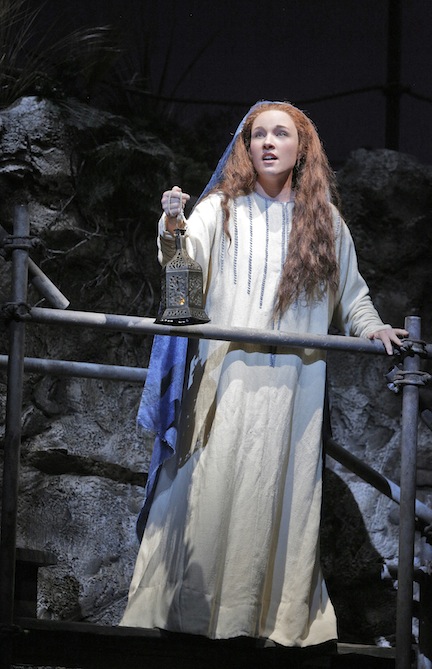
Resinging the story of Jesus
Composer Mark Adamo’s latest opera “The Gospel of Mary Magdalene,” which just closed its run at the San Francisco Opera House this past Sunday, attempts to add another perspective to the stories on the life of Jesus. As Adamo states: “In 2007, I wondered: could one develop … a credibly human original version of the story that we know only from its later and fantastical elaborations—elaborations glamorized by miracle and hardened by dogma?” It’s a project both ambitious and touching in its reach.
What Adamo is actually trying for in the opera, though, is a modernization of the story that includes women as active leaders within Christianity and that endows Jesus with sexuality by linking sexuality to ideals of Love and freedom. To do this the composer began his investigations with a 5th-century papyrus codex bought by a German scholar, Karl Reinhardt in Cairo in 1896 and published in 1955: Berolinensis 8502, known as The Gospel of Mary.
The text of the codex, however, is enigmatic, its fragmented story is mystical and very far from Adamo’s desire for human flesh and bones. Its only link to the opera is found in Peter’s rejection of Mary Magdalene’s understanding of Christ’s words and his drive for authority among the apostles. Peter’s statement “Sister, we know that the Savior loved you more than the rest of woman” hardly merits the earthly marriage that Adamo ratifies. Adamo turns to other apocrypha and his own sense of political correctness to pursue the ideas behind his opera.
Doctrinal consistency or sophisticated religious discussion do not an opera make. A good librettist could have woven ideas and words from the various gospels and apocrypha into the erotic and humanist story Adamo was seeking, but the libretto of this opera is inadequate. The rhymes are awkward and the phrasing of the sentiments banal. Some of the attempts at recreating Song of Song-like passages are just embarrassing. Further, the arias are set in a discursive rather than melodic way, which emphasizes the clumsiness of the language.
The ongoing recitative floats above more complex musical scoring. The orchestration is good, with the swell and sonic power characteristic of film music. Transitions of action are marked by rather groovy percussive interludes. There seemed to be motifs running throughout, but they were difficult to discern. The conductor Michael Christie and the SF Opera orchestra were superb.
Divine voices
What saves this production though are the singers. Sasha Cooke sings Mary Magdalene, and her voice is extraordinary. It combines the warmth of the mezzo tone with the absolute purity of a soprano’s. No stray threads of color disturb the way her sound glides from the center of one note to another. Nathan Gunn was a fitting partner, tall and earthy in both presence and sound.
Brighter vocal palettes were wielded by tenor William Burden, whose voice endowed the competitive Peter with an emotional ping that was gripping, and Maria Kanyova, as Miriam or the not so Virgin Mary. Unfortunately, Kanyova’s part forced her high soprano into a series of complaints about her son’s risky and unconventional behavior and her own ill treatment by her society giving her voice a querulous quality.
The setting was an archeological dig, described in the program notes as: “The time is now. The place is Galilee, the first century C.E.”—that in itself is an indicator of the confusions inherent in the opera. The chorus was dressed in contemporary jeans and shirts. The costumes of the first-century characters, designed by Constance Hoffman, were wonderful. Both the open U-shaped sets, designed by David Korins, and the metaphor of discovery that they suggested seemed viable, but like most things in the opera they didn’t quite achieve the effect they strove for.
—Jaime Robles
Photo: Caption: Sasha Cooke (Mary Magdalene) and Nathan Gunn (Jesus) in San Francisco Opera’s world premiere of Mark Adamo’s “The Gospel of Mary Magdalene.” Photo © Cory Weaver/San Francisco Opera.
